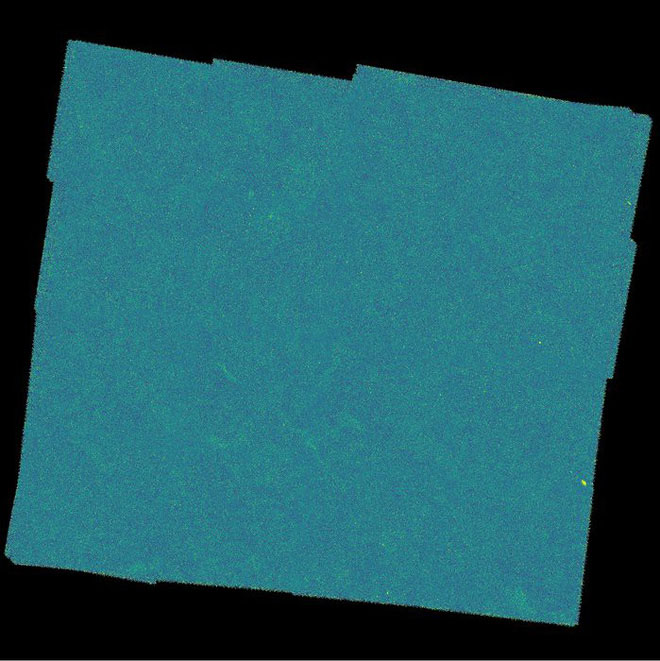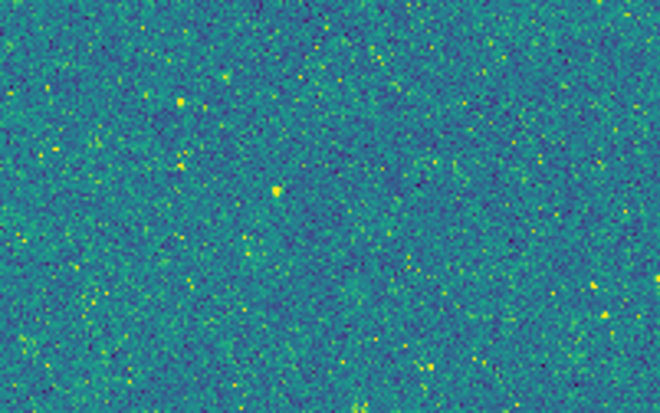You will be surprised to know what the gold dust particles in this photo are actually!
All human knowledge of the universe is still very modest compared to its great stature. Photos recently posted by ESA on your website will definitely help you penetrate this.
Take a look at this picture. What do you think it is?

What do you think is the yellow gold dots in the picture above?
It seemed like it was just a piece of green paper with gold dust particles on it, but it wasn't that simple. This is essentially a picture published by ESA (European Space Agency), to help us visualize the endless expanse of space.
And to make it more clear, every yellow dot you're seeing is a galaxy.
You don't look wrong!Is the galaxy ! Our Milky Way is a galaxy, and in the universe there are countless galaxies. They are represented by yellow dots.

The gold dots are actually galaxies!
The universe is so big that every word, every number seems too limited to describe its greatness. The Galaxy alone, the galaxy we live in, has a diameter of 10,000 light years and contains at least 100 billion stars. And though it was so great, it was just a tiny grain of sand in the vast universe.
This image was captured by ESA's Herschel space telescope. Each point represents the radiant heat emitted from cosmic dust, located in the space between the stars in each galaxy band. This radiation was emitted before the Sun or Earth system formed, that is, we were seeing them billions of years ago.
Weighing only 9MB, this photo captured 180.1 square degrees of the galaxy's northernmost sky (NGP). This is a region far from the Milky Way disc, where the celestial bodies are concentrated. Therefore, the photo provides a view of the open space away from the "giant house" that we live in.
Standing on Earth, positioning scientists rely on astronomical coordinates. The area collected in the image is located near the Hau Phat - constellation containing the gorgeous Coma cluster. Coincidentally, the Coma assemblage was present and contributed 1,000 bright spots to this photo.

Location of the constellation
Photos of the universe like this make people feel their smallness. But more importantly, it is an effective tool to help scientists estimate the total number of galaxies in the universe observed through extrapolation.
Two years ago, astronomers realized that the universe contained 10 to 20 times the number of galaxies previously calculated, and that was just the part of the universe we observed.
The latest estimate is that the universe in the observation area contains one to two trillion galaxies. The universe is full of stars, about 700 million six (7 with 23 zeros behind) the star in the cosmological horizon we can reach.
- Close up of asteroid dust through a microscope, revealing many mysteries
- Extremely fast gold emulsion from electronic waste
- Sahara dust, who 'sabotage' Caribbean summer
- The assassin hid under the mask for 10 days inhaling Beijing's air
- Dust covering the Chinese city is harder than steel
- Dust particles will become
- We come out of the dust, and then come back to make dust - what is dust after all?
- PM2.5 fine dust pollution: Invisible killer
- 'Magic dust' could be the foundation for future supercomputers
- Dangerous dust causes DNA alteration and many labeling problems
- Why does breathing also cause obesity?
- Detecting pollution dust attacking the brain
 Van Allen's belt and evidence that the Apollo 11 mission to the Moon was myth
Van Allen's belt and evidence that the Apollo 11 mission to the Moon was myth The levels of civilization in the universe (Kardashev scale)
The levels of civilization in the universe (Kardashev scale) Today Mars, the sun and the Earth are aligned
Today Mars, the sun and the Earth are aligned The Amazon owner announced a secret plan to build a space base for thousands of people
The Amazon owner announced a secret plan to build a space base for thousands of people